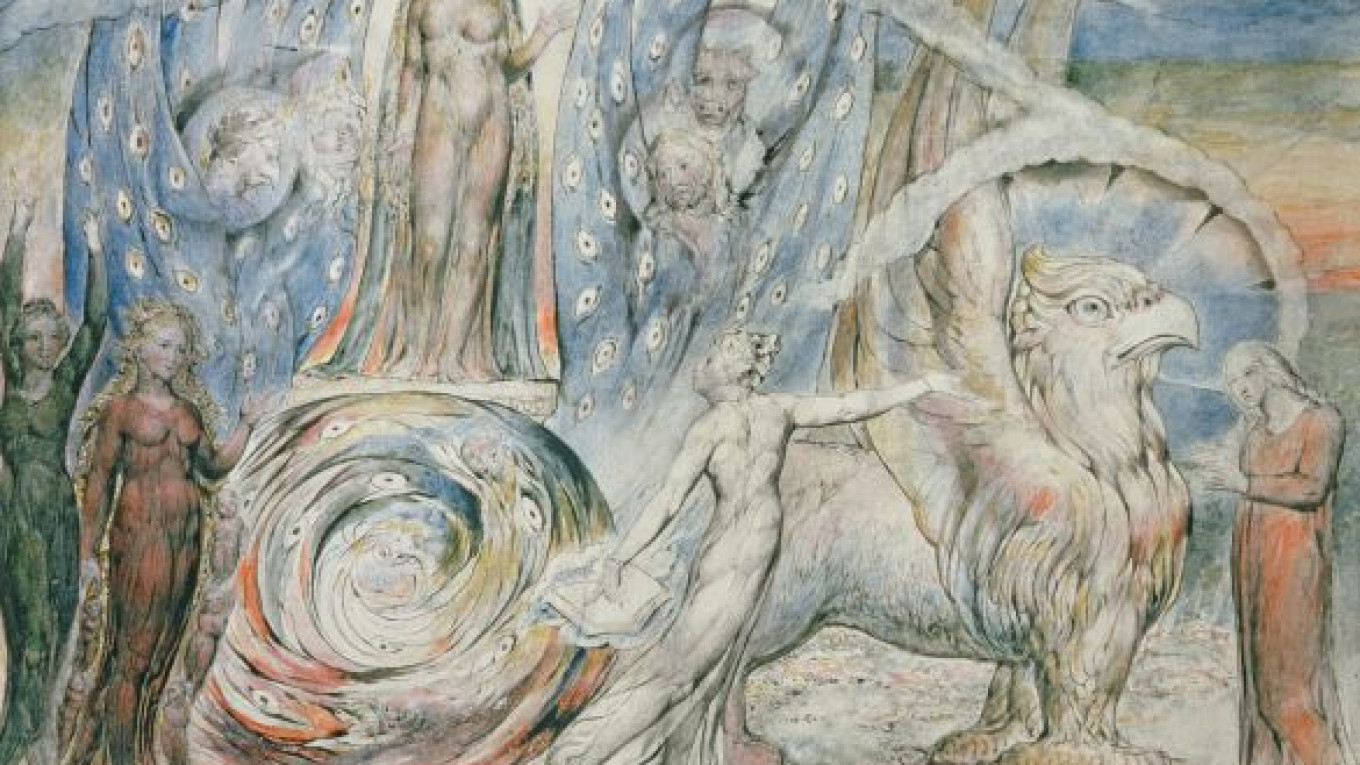Moscow's Pushkin Museum of Fine Arts is paying tribute to English romantic writer William Blake, the poet and artist famed for his florid imagination and unconventional views.
The exhibition — now at its midpoint — comprises about 150 paintings, engravings and drawings, including some 110 works by Blake himself as well as paintings by those he influenced, among them the 19th-century Pre-Raphaelites and 20th-century artist Francis Bacon.
It is the first such showing of Blake's artwork in Russia. After holding translation competitions and conferences in mid-2011, "we understood that the Russian public was particularly interested in Blake and his understanding of a book," said Tatyana Tyutvinova, curator of British prints and drawings at the museum.
"The work of Blake — which incorporates philosophy, printmaking and poetry — has provoked a great deal of positive feedback, … we may organize a follow-up exhibition," she said.
By focusing on Blake's artwork, the Moscow exhibition stays true to Blake's apprenticeship as an engraver and artistic training at London's Royal Academy, but strays from his present-day reputation in his homeland, where he is perhaps better known for his writing.
Blake's name is most commonly associated in Britain with "Songs of Innocence and Experience" (1789), a collection of poems and accompanying illustrations composed and printed by Blake himself, and the lyrics to the well-known hymn "Jerusalem," which he penned as a poem of the same name and which hangs at the entrance to the Moscow exhibit.
Russian audiences first became acquainted with Blake in the early 20th century, following the first Russian translations of his poetry by Zinaida Vengerova and Konstantin Balmont, and he has enjoyed considerable popularity in Russia since.
"He is well known as a writer and revolutionary thinker in Russia, and I'm very interested to hear how Russian audiences will respond to his visual art," said Penelope Curtis, director of Tate Britain, which lent the bulk of the works on display.
The reception has been warm so far, with visitors packing the museum on a recent morning visit.
Blake's work was often received with mocking criticism when he was alive, while he himself was dismissed as a lunatic.
Today, he is viewed as one of Britain's most influential creative figures, fascinating not only for his diverse body of work, but also for his colorful, at times heretical beliefs.
Besides championing the supremacy of the imagination over the rationalism espoused by his 18th-century contemporaries, Blake also claimed to see visions of angels and various historical luminaries from a young age. He was also an outspoken critic of the British authorities and was tried for high treason in 1803 after reportedly uttering the words: "Damn the king, his soldiers are all slaves."
Visitors to the Moscow show can sense something of Blake's controversial beliefs in the covert challenges to prevailing Newtonian thought and orthodox Christianity contained in his artwork.
In "Newton" (1795-1805), for instance, Blake depicts the scientist drawing with a compass on a scroll that emanates from his mouth in an image that appears to suggest Newton's theories are little more than a figment of his imagination.
Elsewhere, the poet-artist's vividly imaginative renderings of biblical scenes take center stage, as in "The Body of Abel Found by Adam and Eve" (1826). Here Blake shows Cain interrupted while burying his brother Abel. On discovering the body, Adam turns to Cain in horror and Eve throws herself over the corpse in grief, while Cain tears at his hair and flees.
Blake's illustrations to Dante's "The Divine Comedy" provide a further highlight, marked as they are by Blake's striking use of color and ability to reinterpret established works. Completed in the three years before his death in 1827, they also provide an excellent segue to the separate room at the end of the museum's colonnade that houses works by British artists who followed on from Blake, including founder of the Pre-Raphaelite movement Dante Gabriel Rossetti.
"William Blake and British Visionary Art" runs till Feb. 19 at the Pushkin Museum of Fine Arts, 12 Volkhonka. Metro Kropotkinskaya. .
A Message from The Moscow Times:
Dear readers,
We are facing unprecedented challenges. Russia's Prosecutor General's Office has designated The Moscow Times as an "undesirable" organization, criminalizing our work and putting our staff at risk of prosecution. This follows our earlier unjust labeling as a "foreign agent."
These actions are direct attempts to silence independent journalism in Russia. The authorities claim our work "discredits the decisions of the Russian leadership." We see things differently: we strive to provide accurate, unbiased reporting on Russia.
We, the journalists of The Moscow Times, refuse to be silenced. But to continue our work, we need your help.
Your support, no matter how small, makes a world of difference. If you can, please support us monthly starting from just $2. It's quick to set up, and every contribution makes a significant impact.
By supporting The Moscow Times, you're defending open, independent journalism in the face of repression. Thank you for standing with us.
Remind me later.






